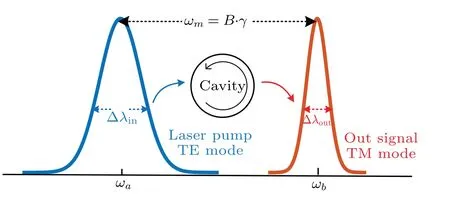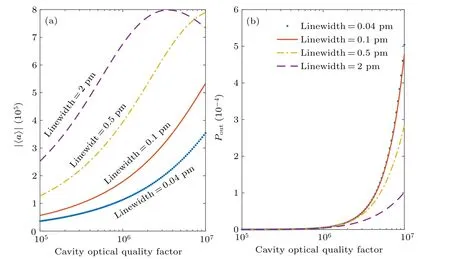Optomagnonically tunable whispering gallery cavity laser wavelength conversion
2023-03-13YiningZhu朱奕宁ZixuZhu朱子虚AnbangPei裴安邦andYongPanGao高永潘
Yining Zhu(朱奕宁) Zixu Zhu(朱子虚) Anbang Pei(裴安邦) and Yong-Pan Gao(高永潘)
1International School,Beijing University of Posts and Telecommunications,Beijing 100876,China
2School of Information and Communication Engineering,Beijing University of Posts and Telecommunications,Beijing 100876,China
3School of Electronic Engineering,Beijing University of Posts and Telecommunications,Beijing 100876,China
Keywords: cavity optomagnonics,YIG sphere,laser modulation
1.Introduction
Magnon, firstly introduced by Bloch,[1]is the collective spin wave excitation carrying quantized energy in a magnetically ordered ground state.In practice, magnons can couple with various subjects, such as microwaves,[2-4]phonons,[5-7]and photons.[8-10]Among these interactions, the magnonphoton interaction, or optomagnonics, communicates the two most widely used wavebands in the field of communication today, microwave and optical communication waves.In this prospect, magnons have drawn significant research interests over the past decades.
With the rapid growth of quantum research and progress of high precision micro-fabrication technologies, optomagnonic microcavity has emerged as a novel research field.[9-14]Yutakaet al.firstly observed the strong coupling between photons and magnons in the quantum regime below 1 K.[4]Zhanget al.demonstrated an enhanced Brillouin scattering process through triply resonant magnon,pump,and signal photon modes inside a yttrium iron garnet(YIG)cavity,[15]because the YIG has large gyromagnetic ratio and low magnetic dissipation rate.Recently, researchers have begun to pay attention to applications of optomagnonics, such as photon blockades and frequency combs.[15-23]
In this work, we propose a laser wavelength conversion method based on optomagnonics, which converts the incoming photons to the orthogonal polarization direction in different wavelengths.The setup is shown in Fig.1,following an attested model developed by Tanget al.[10]In whispering gallery mode cavities,the Faraday effect changes the polarization direction of EM waves to its orthogonal direction.Therefore,an input of TE mode laser gives out an output of TM mode.The optical TE and TM modes are inelastically scattered by magnons.Due to the conservation of the energy, the difference in the wavelength between the two optical modes is the same as the static magnetic field adjustable frequency of the magnons.We give the energy conversion features of the system for the gaussian laser.The result will benefit the wide range,continuous modulation of the coherent light.

Fig.1.The schematic diagram of the proposed modulation configuration.Two inner modes, TE (TM) polarized with frequency ωa (ωb),reside in the YIG sphere.TE polarized photon centered at ωL is coupled into the YIG sphere by a fiber laser.A microwave pump is also applied whose frequency is ωmw.The whole setup is under a static magnetic field B.
2.Theory
The Hamiltonian of the studied system incorporates three parts: the Hamiltonian of free optical and magnetic mode,the photon-magnon interaction,and the bath.We use operatorsa,b,mto denote the annihilation operator of the optical transverse electric (TE) mode, optical transverse magnetic (TM)mode, and the magnon, and useωa,ωb,ωmas the respective eigen-frequencies;gstands for the coupling factor.The system is laser and microwave pumped,and the pump frequencies areωL,ωmwrespectively.We useκa,exandκm,exto denote the external coupling rate to laser and microwave pumps.Therefore,the Hamiltonian can be written as
For the maximal conversion,we need to align the frequency of the microwave pump to the frequency of the excited magnon to induce the triple resonance,ωm=ωmw,in that case the TM transmission can be simplified to
In practice, the linewidth of the laser pump is usually in the sub-picometer regime and the experimental cavity quality factor of the YIG sphere is below 107.Therefore,we can safely assume that the linewidth of the laser is far less than that of the cavity,that is Δλin≪Δλcav.Under this approximation,we obtain
where A is the amplitude of the output spectrum:
3.Results and discussion
In the following we discuss the performance of the laser tuning process.We set the eigen-frequency of the cavity TE mode to match the central frequency of the laser pump,that is,ωa=ωL.

Fig.2.The frequency modulation scheme.The input TE polarized photon centered at ωa are scattered to TM polarized photon centered at ωb.The frequency difference is determined by ωm =B·γ, which can be adjusted by the static field strength.
As shown in Fig.2, during the inelastic collision of optomagnonics, the output TM mode frequencyωbis the sum of the pump field frequencyωaand the magnon frequencyωmsubjected to the conservation of energy.Moreover, the magnon frequency solely depends on the magnetic field intensity,ωm=B·γ.Therefore, the frequency difference of the input and output field is proportional to the applied magnetic field.Thus,the output frequency can be tuned by the applied magnetic field.For wavelength modulation,another issue we need to pay attention to is the conversion rate of energy.We assume a fixed applied magnetic field as 2410 Oe.Considering the YIG sphere’s gyromagnetic ratio 2π·2.8 MHz/Oe,this amounts to a magnon frequency of 6.75 GHz.
One key factor impacting the conversion efficiency is the optical and magnetic quality factor of the cavity.The optical dissipation ratio scales with cavity optical quality factor by the relationδλa=κa=ωa/Q, whereωais the eigen-frequency of the cavity TM mode.As shown in Eq.(8),the optical dissipation ratio impacts the laser pump coupling strength and the output power directly, therefore we ramp the quality factor of the cavity and observe the output signal bandwidth,the inner field strength, and the output power, respectively.The frequency of the Gaussian profile pump laser is centered at 1550 nm with 0.03 mW power.The bandwidth of the laser pump varies from 0.04 pm to 2 pm to investigate the relation between the laser bandwidth and the cavity optical quality factor.
Figure 3(a) shows the inner TE mode strength〈a〉with respect to the cavity factor.As suggested by Eq.(4),the mode strength profile is determined by the mode dissipation ratioκaand the external couplingκa,ex.Since the external coupling rate can be adjusted by the placement of the optical fiber and the physical configuration of the joint structure, we can safely set the external coupling rate to the critical point whereκa,ex=0.5κato reach the maximum coupling efficiency.We can find that all except the laser with 2 pm linewidth show a monotonous increase as the cavity quality factor increases,because a higher quality factor means a higher optical storage capacity.However,the pump with 2 pm linewidth shows an increase followed by a steady decrease in the field strength.This is because,for the lower external coupling in the off-resonance region,it is difficult for a laser with large linewidth to be coupled in.It should also be noted that the maxima of this group indicate the optimal coupling of the Gaussian laser.
To generate the modulated signal,the purposed operation sequence should follow after.
Firstly,get the static magnetic field strength according to the gyromagnetic ratio of the cavity material and the desired modulation frequency.Then,apply the static magnetic field to the cavity to excite the magnons with a specified frequency.
In order to amplify the output TM signal by the triple resonance process, apply a microwave signal with a frequency equalling that of the magnons.
Apply the laser pump to couple into the cavity in the TE mode and collect the output TM signal.
To study this scheme, we set the frequency of the microwave to 6.75 GHz, the same as the magnon frequency inside the cavity, and the microwave pump power is fixed at 320 mW.All these parameters are experimentally achievable.We demonstrate the power of the output TM mode in Fig.3(b).As the cavity quality factor increases,the output power grows monotonously.At the maximum cavity quality factor,the output power differences are evident for lasers with linewidth greater than 0.5 pm, whereas for laser pumps with a finer linewidth,the output power difference is negligible,which indicates the impact of laser linewidth vanishes when the relation Δλin≪Δλcavis satisfied.However, it should be noted that this result only holds for a relatively low quality factor,i.e.,Q ≤107.For cavities with a much higher quality factor,usually 108or higher, an off-resonant term must be considered.Then the influence of the cavity quality factor will not be monotonous.

Fig.3.(a)The cavity TE mode field strength,and(b)the output TM polarized power,Pout with respect to the cavity optical quality factor.The powers of the laser and microwave pump are 0.03 mW and 320 mW,respectively.The magnetic dissipation factor of the cavity is 5 MHz.The frequencies of cavity magnon and microwave pump are 6.75 GHz.The g coupling factor is set to 50 Hz.
When the optical mode is modulated by the cavity, the power profile of the output signal may also be changed.Under the assumption that the input laser has a Gaussian profile in the frequency domain, the full width at half maximum (FWHM)is the input laser’s linewidth Δλin.Figure 4 demonstrates one of the cavity’s characteristics as a frequency filter by showing variation of the bandwidth ratio, Δλin/Δλout, with respect to the optical quality factor.Initially,the output profile is slightly affected and the ratio is close to 1 under the lowest cavity quality factor condition of Δλin≪Δλcav.Thus, for laser pumps with small linewidth, a cavity with a quality factor less than 107has little impact on the output bandwidth.It should be noted that for laser pumps with linewidth 0.5 pm and linewidth 2 pm,the bandwidth ratio decreases significantly as the cavity becomes finer when the cavity linewidth has the same magnitude as the laser.This shows a strong filter effect, and the output profiles become sharper in the frequency domain.Then the higher quality factor cavity can be used to convert the laser frequency and its linewidth.As suggested by Eq.(10), the magnetic quality factor seems to play similar roles as the optical quality factor.However,the magnetic quality factor’s influence on the coupling and output power is limited.While the optical quality factor can be improved by decreasing the surface roughness,the adjustability of magnetic quality factors is limited, which is mainly determined by the material properties.

Fig.4.The input-output bandwidth ratio, Δλout/Δλin, with respect to the cavity optical quality factor.
As a parameter describing the connection between the TE and TM mode,the couplinggfactor will also impact the output TM mode.Therefore, we study the output TM power profile under differentgcoupling factors in Fig.5.It can be found that the cavity with a highergcoupling factor has a better conversion performance, but thegfactor does not influence the linewidth of the output TM mode because all these frequency spectra have the same linewidth.This means that we can increase the coupling factor to increase the energy conversion without the need to consider the effect on the laser frequency distribution.
The results indicate that the conversion efficiency of our purposed system is relatively low in the current stage.However, we only adopt parameters that are currently experimentally achievable,whereas remarkable improvement in the conversion efficiency is feasible with the advance in materials and coupling technologies.For instance, Kobayashiet al.purposed a metal-fluoride nanogranular film that can produce Faraday rotation 40 times larger than the BI-YIG material.[24]As suggested by Eq.(10),adopting such a material will lead to 1600 times increase in conversion efficiency,which will make the configuration practical.

Fig.5.The frequency spectrum of output TM polarized signal with different g coupling factors.The laser pump linewidth is 0.5 pm and the cavity optical quality factor is 107.
4.Conclusion
In summary, we have proposed a method to modulate a TE mode laser to get TM polarized output with the whispering-gallery mode cavity optomagnonics.Under the 320 mW pump,we can obtain a 600µW output.By numerical simulation, the key parameters impacting the performance of the modulation are discussed.We find that the optical quality factor of the cavity and the couplinggfactor are positively correlated to the quality factor of the cavity, and the output profile in the frequency domain is slightly compressed when Δλin≪Δλcav.We find that,to reach the best conversion efficiency,the linewidth of the pump laser should match the cavity quality factor.The cavity with a highergcoupling factor means a higher output efficiency without affecting frequency distribution.Our scheme presents a new non-contact laser frequency modulation scheme that is different from previous ones that require mechanical modulation or applied voltage.
Acknowledgement
Project supported by the National Natural Science Foundation of China(Grant No.62101057).
猜你喜欢
杂志排行
Chinese Physics B的其它文章
- Matrix integrable fifth-order mKdV equations and their soliton solutions
- Comparison of differential evolution,particle swarm optimization,quantum-behaved particle swarm optimization,and quantum evolutionary algorithm for preparation of quantum states
- Explicit K-symplectic methods for nonseparable non-canonical Hamiltonian systems
- Molecular dynamics study of interactions between edge dislocation and irradiation-induced defects in Fe-10Ni-20Cr alloy
- Engineering topological state transfer in four-period Su-Schrieffer-Heeger chain
- Spontaneous emission of a moving atom in a waveguide of rectangular cross section
